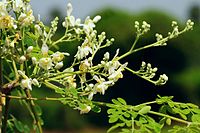
Photo from wikipedia
Planting date and cultivar maturity group (MG) are major management factors affecting soybean [Glycine max (L.) Merr.] yield, but their effect on seed oil and protein concentration, and in particular… Click to show full abstract
Planting date and cultivar maturity group (MG) are major management factors affecting soybean [Glycine max (L.) Merr.] yield, but their effect on seed oil and protein concentration, and in particular meal protein concentration, is less understood. We quantified changes in seed oil and protein, and estimated meal protein concentration, and total oil and protein yield in response to planting date and cultivar MG ranging from 3 to 6 and across locations comprising a 8.3° range in latitude in the U.S. Midsouth. Our results show that delayed planting date and later cultivar maturity reduced oil concentration, and this was partially associated with a decrease in temperature during the seed fill phase. Thus, optimum cultivar MG recommendations to maximize total oil yield (in kg ha–1) for planting dates in May and June required relatively earlier cultivar MGs than those recommended to maximize seed yield. For planting dates in April, short-season MG 3 cultivars did not increase oil yield compared to full-season MG 4 or 5 cultivars due to a quadratic yield response to planting date at most locations. Planting date and cultivar maturity effects on seed protein concentration were not always consistent with the effects on estimated meal protein concentration after oil extraction. Meal protein concentration decreased with lower temperatures during seed fill, and when the start of seed fill occurred after August 15, but relatively short-season cultivar MGs reduced the risk of low meal protein concentration. Meal protein concentration is a trait of interest for the feed industry that would be beneficial to report in future studies evaluating genetic, management, and environmental effects on seed protein concentration.
Journal Title: Frontiers in Plant Science
Year Published: 2022
Link to full text (if available)
Share on Social Media: Sign Up to like & get
recommendations!